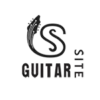Best Distortion Pedal Per Category - Our Top 12 List Uncovered
- Raphael Pulgar
- March 28, 2024
- 8 Comments
Distortion pedals are devices that alter the sound of a guitar by clipping the signal, creating a distorted or fuzzy tone. The best distortion pedals add character, dynamics, and expression to the sound. Distortion pedals can also create rock, metal, blues, and punk musical genres.
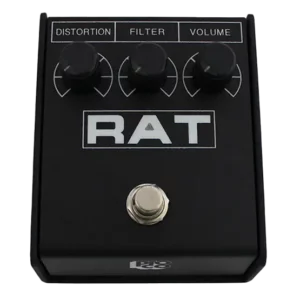
ProCo RAT
The RAT is a classic pedal that can tackle a multitude of genres as exemplified by its roster of notable users.
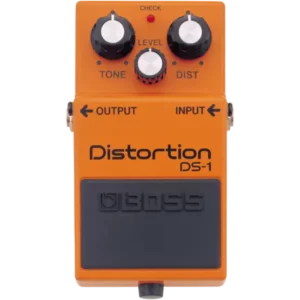
Boss DS-1 Distortion
The Boss DS-1 is a bestseller for a reason. It's a classic sound that both virtuosos and punks can enjoy.
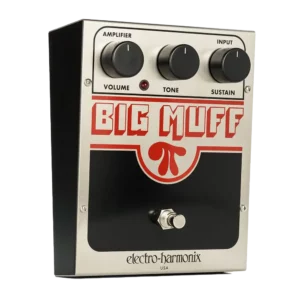
Electro-Harmonix Big Muff
An alt-rock darling, The Electro-Harmonix Big Muff's thick aggressive sound makes it a genre-defining pedal for any guitarist.
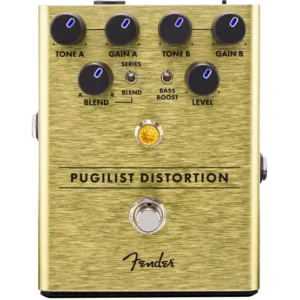
Fender Pugilist
The Pugilist is a highly tweakable gain pedal with two gain stages that can be run in series or parallel for a variety of tones.
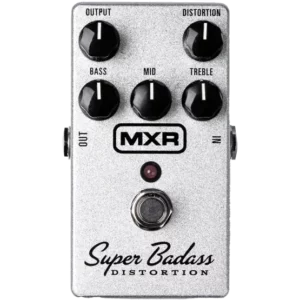
MXR Super Badass
The MXR Super Badass Distortion is your ultimate solution for achieving a versatile range of analog distortion.
We’re reader-supported. When you click product links on our site, we may earn an affiliate commission at no extra cost to you.
Today, guitarists have a plethora of options when it comes to distortion pedals. the best distortion pedals emulate classic sounds, such as the ProCo RAT, the Boss DS-1, and the Electro-Harmonix Big Muff. Some distortion pedals offer modern features, such as the Fender Pugilist, the MXR Super Badass, and the Wampler Sovereign. Additionally, there are versatile, adaptable, and affordable distortion pedals, such as the TC Electronic Dark Matter, the JHS Angry Charlie, and the Mooer Black Secret. With so many choices, guitarists can find the best distortion pedal for their needs and preferences.

- Table of Contents
The Classics: Time-Tested Distortion Pedals
Best Classic
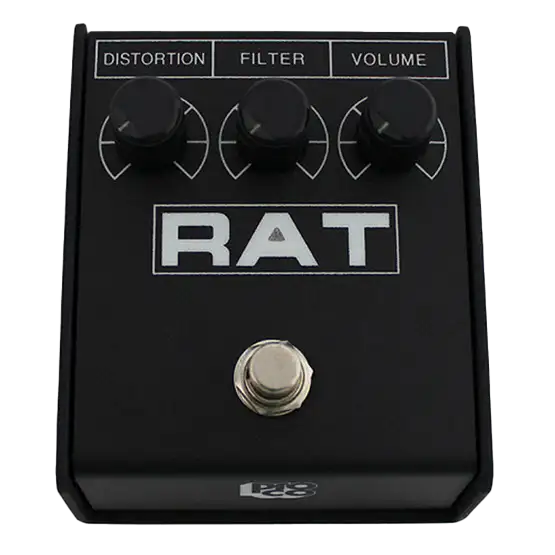
ProCo RAT
Guitarsite Expert Opinion
The RAT, with its sleek and simple 3-knob layout, offers a wide range of tones, from smooth overdrive to wild and wooly fuzz. No wonder it’s become a go-to choice for guitarists who want versatility without sacrificing simplicity.
We’re reader-supported. When you click product links on our site, we may earn an affiliate commission at no extra cost to you.
The ProCo Rat is a renowned distortion pedal capable of producing a wide range of tones, ranging from smooth overdrive to aggressive fuzz. It features a simple design with three tone shaping controls: Distortion, Filter, and Volume. The Distortion knob controls the amount of gain, while the Filter knob acts as a reverse tone knob that cuts treble as you turn it clockwise. The Volume knob adjusts the output level.
The Rat is famous for its gritty, harmonically rich sound that can cut through the mix. It works well with guitars and amps and can be used for various genres, such as rock, metal, blues, and punk. Some notable users of the Rat include Kurt Cobain, Jeff Beck, and David Gilmour. Bands like Sunn O))) Have built their signature sound around the RAT pushing an already overdriven amp.
The Rat is also an affordable and durable pedal that has been around for more than four decades. It has undergone several revisions and variations, but the original circuit remains largely unchanged. The Rat is a versatile and reliable pedal that can deliver great tones for any guitarist.
Pros:
- Unique tonal character
- Sturdy Construction
Cons:
- Might not be tight enough for modern metal
Specifications: | |
|---|---|
Pedal Type: Distortion, Fuzz, Overdrive
| Analog/Digital: Analog
|
Inputs: 1 x 1/4″
| Outputs: 1 x 1/4″
|
Buffer Switching: True Bypass
| Controls: Distortion, Filter
|
Power Source:9 V DC power supply (sold separately)
| Batteries: 1 x 9V |
Best for 90s Rock and Grunge
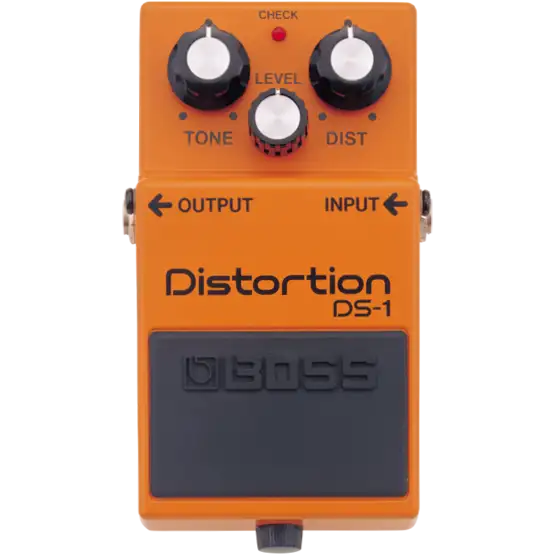
Boss DS-1 Distortion
Guitarsite Expert Opinion
The BOSS DS-1 is a popular distortion pedal with a Level knob for balancing volume, a Tone control for shaping sound, and an affordable price. It’s great for beginners and legendary guitarists like Steve Vai and Kurt Cobain.
We’re reader-supported. When you click product links on our site, we may earn an affiliate commission at no extra cost to you.
The Boss DS-1 is a highly popular distortion pedal extensively used by renowned guitarists such as Steve Vai, Kim Deal (on bass), Peter Steele, Joe Satriani, Kurt Cobain, and Mike Stern. Its classic sound is often associated with distorted guitar tones. The DS-1 is characterized by its gritty and uncompromising sound, which has become a hallmark electric guitar tone for modern rock. It sounds best when going through a tube amp with a little bit of grit.
The DS-1 also responds well to stacking with an overdrive pedal. Steve Vai has used one in conjuction with an Ibanez Tube Screamer. In fact, his signature Ibanez Jemini pedal employs the same concept.
There is also the DS-1W which is an upgraded version of the pedal that features a “custom mode” for more versatility and dynamic range along with a midrange and volume boost.
Its circuitry comprises an op-amp and a pair of clipping diodes that produce its unique sound. The DS-1’s tone control is a simple low-pass filter that allows users to adjust the treble and bass frequencies. Its level control adjusts the output volume, while its distortion control regulates the amount of gain applied to the signal. Overall, this legendary Boss pedal is a versatile and reliable distortion pedal that has stood the test of time.
Pros:
- Great for rock and punk
- Easy to use
- Extremely durable
Cons:
- Not ideal for solid state amps
Specifications: | |
|---|---|
Pedal Type: Distortion
| Analog/Digital: Analog
|
Inputs: 1 x 1/4″
| Outputs: 1 x 1/4″
|
Bypass Switching: Buffered Bypass
| Controls: Tone, Level, Dist
|
Power Source: 9 V DC power supply (sold separately)
| Batteries: 1 x 9V |
Best for Indie and Alternative
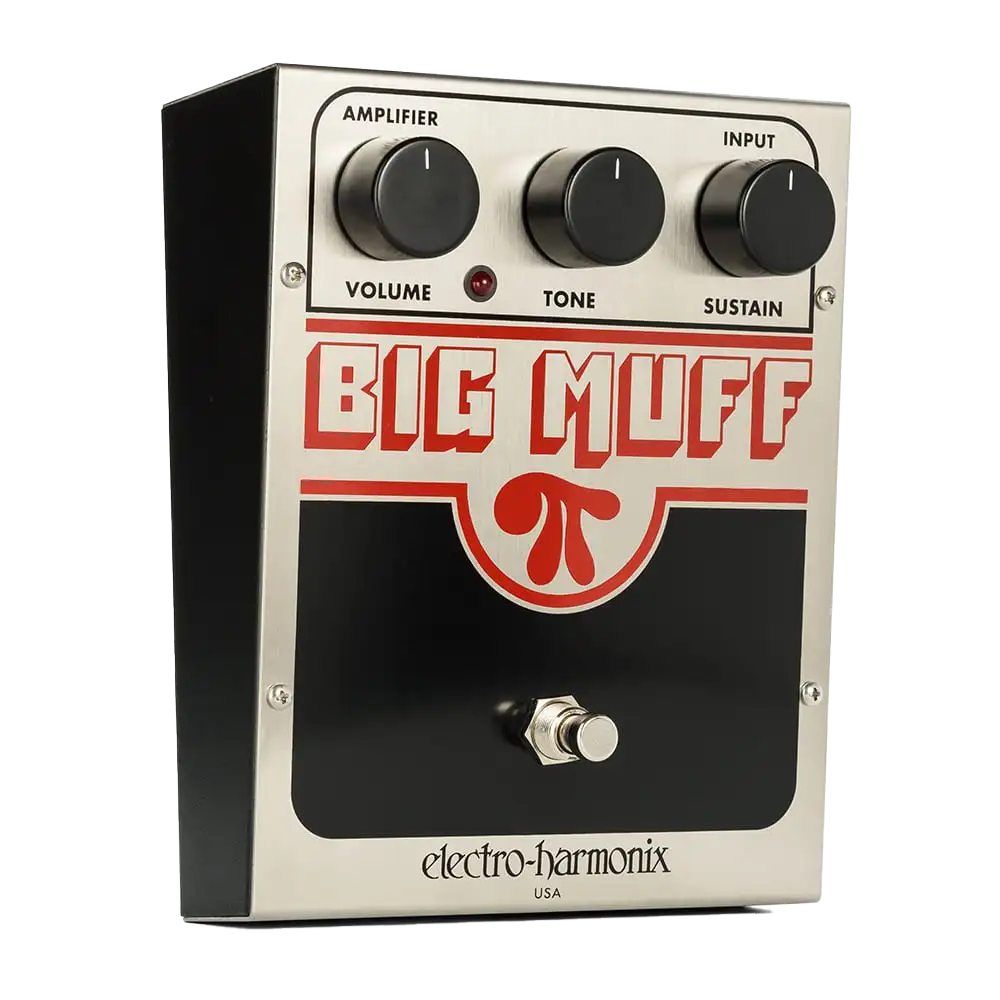
Electro-Harmonix Big Muff
Guitarsite Expert Opinion
This bad boy is famous for delivering a crushing distortion that’ll give you goosebumps. And if you’re into heavy rhythm playing, leads, or grungy tones, you’re going to love this pedal.
We’re reader-supported. When you click product links on our site, we may earn an affiliate commission at no extra cost to you.
The Big Muff is a highly acclaimed fuzz/distortion pedal widely recognized and used by numerous artists. Its rich, harmonically complex sound with thick, saturated overtones offers a perfect platform for creating massive walls of fuzz through its unique tone-shaping capabilities.
The Big Muff bridges the gap between distortion pedals and fuzz pedals, which is why we chose to include it here. While it doesn’t do full on metal distortion, its distinctive tone has made its imprint on many acclaimed albums.
The pedal’s circuit architecture comprises three stacked gain stages, which lead to a highly responsive and dynamic sound output. It also offers a wide range of tonal options, including a switchable tone stack that enables users to tailor the pedal’s frequency response to their liking.
The Big Muff has been used extensively by renowned musicians such as David Gilmour (Pink Floyd), J Mascis (Dinosaur Jr.), and Dan Auerbach (The Black Keys), to name a few. Its enduring popularity owes to its ability to produce vintage tones and modern sounds that are highly sought-after in today’s music scene.
Pros:
- Classic tone
- Simple controls
- Thick sustain
Cons:
- Large footprint
- Odd tone stack
Specifications: | |
|---|---|
Pedal Type: Distortion/Fuzz
| Analog/Digital: Analog
|
Inputs: 1 x 1/4″
| Outputs: 1 x 1/4″
|
Bypass Switching: True Bypass
| Controls: Volume, Tone, Sustain
|
Power Source: 9 V DC power supply (sold separately)
| Batteries: 1 x 9V |
Modern Titans: High Gain Distortion Pedals For Metal
Fender Pugilist
Best for Modern Rock
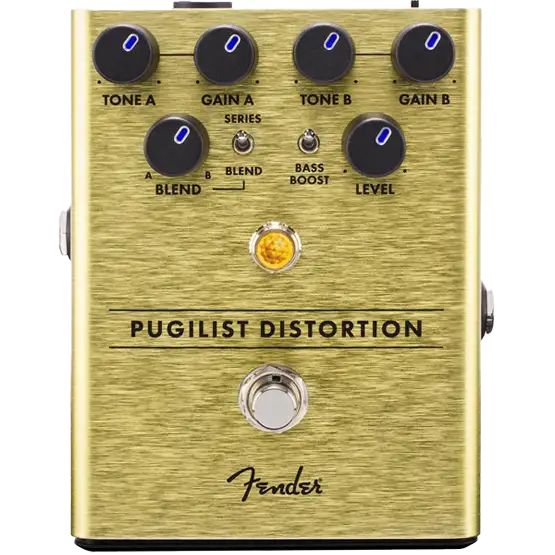
Fender Pugilist
Guitarsite Expert Opinion
If you’re looking for a distortion pedal that can handle both vintage and modern tones, the Fender Pugilist Distortion Pedal is definitely worth checking out. With two channels to play with, you can get a smooth, classic sound from Channel A, or crank up the aggression with Channel B’s tight low-end response and increased gain.
We’re reader-supported. When you click product links on our site, we may earn an affiliate commission at no extra cost to you.
The Fender Pugilist is a versatile and powerful dual-channel distortion pedal. It allows you to blend dual gain engines, each with its own gain and tone controls, providing a variety of distortion tones. You can also choose to run the engines in series, which produces a more intense sound. The bass boost switch allows for more aggressive lows ideal for modern rock and metal.
This pedal is perfect for those who want to explore different shades of distortion, ranging from smooth overdrive, to vintage metal distortion, to aggressive fuzz.
It works well with various guitars and amps and can cover many genres, including rock, metal, blues, and punk. Some standout features include the magnetic battery compartment, the LED-illuminated knobs, and the durable construction.
The Fender Pugilist is an excellent addition to Fender’s new line of effects pedals and a worthwhile choice for any distortion enthusiast.
Pros:
- Versatile gain range
- Sturdy build
- Also great at medium gain
Cons:
- Blending gain stages may be too complex for beginners
Specifications: | |
|---|---|
Pedal Type: Distortion
| Analog/Digital: Analog
|
Inputs: 1 x 1/4″
| Outputs: 1 x 1/4″
|
Bypass Switching: True Bypass
| Controls: Tone A, Tone B, Gain A, Gain B, Blend, Level, Series/Blend, Bass Boost
|
Power Source: 9 V DC power supply (sold separately)
| Batteries: 1 x 9V |
Best for 80s Metal
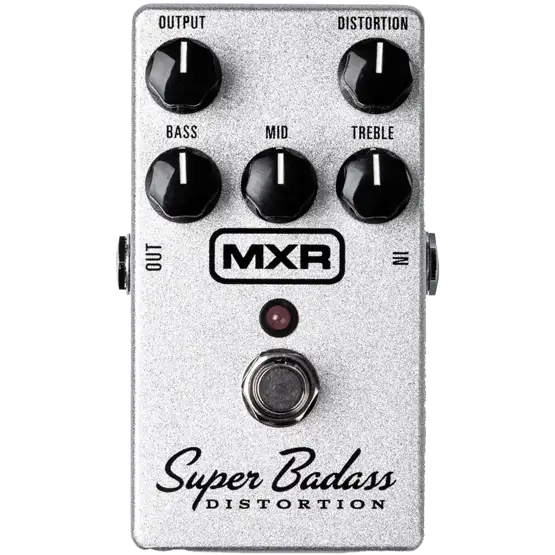
MXR Super Badass
Guitarsite Expert Opinion
This little wonder packs an encyclopedia of versatile sounds that are perfect for rock, blues, metal, and just about any other genre you can think of. With its active EQ section, rugged build, and intuitive controls, the Super Badass Distortion is sure to become your go-to pedal for all your distortion needs.
We’re reader-supported. When you click product links on our site, we may earn an affiliate commission at no extra cost to you.
The MXR Super Badass is a distortion pedal that offers a modern take on vintage distortion. It has a three band EQ that lets you sculpt your tone precisely and a wide gain range that can go from bluesy breakup to full-on distortion. It’s one of the best versatile distortion pedals today, covering various genres and styles like hard rock.
This compact pedal has a simple design with four knobs: Output, Distortion, Bass, Mid, and Treble. The Output knob controls the volume level, the Distortion knob adjusts the amount of saturation, and the Bass, Mid, and Treble knobs shape the frequency response. The pedal also features true bypass switching and a sturdy metal enclosure.
The Super Badass delivers a rich, harmonically saturated distortion that can cut through the mix. It works well with guitars and amps and can emulate classic tones or create new ones. Some artists who have used the Super Badass include Slash, Billy Gibbons, and John Frusciante.
Pros:
- Flexible Eq
- Great touch response
- Versatile
Cons:
- Not for vintage, pre-70s tones
Specifications: | |
|---|---|
Pedal Type: Distortion
| Analog/Digital: Analog
|
Inputs: 1 x 1/4″
| Outputs: 1 x 1/4″
|
Bypass Switching: True Bypass
| Controls: Output, Distortion, Bass, Middle, Treble
|
Power Source: 9 V DC power supply (sold separately)
| Batteries: 1 x 9V |
Best for Modern Metal
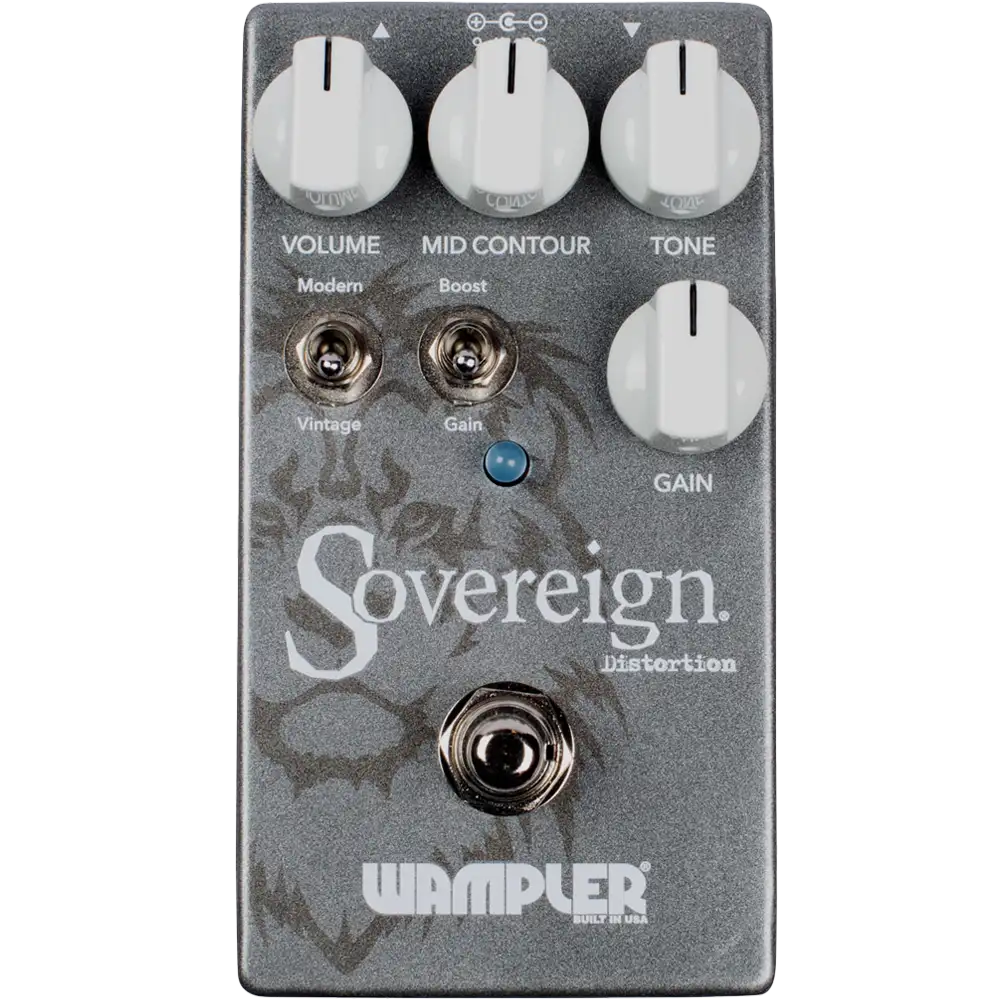
Wampler Sovereign
Guitarsite Expert Opinion
This versatile stompbox is not just any ordinary pedal that aims to emulate a specific amp. It offers so much more with its advanced gain structure, tone shaping knobs, and harmonic-rich sound that can create a world of difference in your music.
We’re reader-supported. When you click product links on our site, we may earn an affiliate commission at no extra cost to you.
The Wampler Sovereign is a premium-quality distortion pedal that offers a vast tonal range, ranging from subtle overdrive to extreme high-gain saturation. It comes equipped with four knobs and two switches that provide precise control over your sound. The knobs include Volume, Mid Behavior, Tone, and Gain, while the switches include Advanced Gain Structure and Bright/Even.
The Sovereign is designed to be compatible with any guitar and amplifier and effectively respond to your playing dynamics and touch sensitivity. It produces rich harmonics, smooth sustain, and tight crunch, making it ideal for rhythm and lead playing. It is also suitable for various genres, such as rock, metal, blues, and punk.
What I feel is missing with the Wampler Sovereign is a built in noise gate. However, separate noise gate pedals often do a better job at attenuating noise and hiss. It’s just a matter of pedalboard space at this point.
The Sovereign is a true bypass pedal. Aside from this, a soft switch and magnetic battery compartment are some of the features that make it one of the best distortion pedals for modern metal tone. Additionally, it is built with high-quality components and has a sturdy metal enclosure, ensuring durability and longevity.
Pros:
- Great tonal range
- Rich harmonics
- Topnotch build quality
Cons:
- Has a learning curve
- Expensive
Specifications: | |
|---|---|
Pedal Type: Distortion
| Analog/Digital: Analog
|
Inputs: 1 x 1/4″
| Outputs: 1 x 1/4″
|
Bypass Switching: True Bypass
| Controls: Volume, Mid Contour, Tone, Gain, Modern/Vintage, Boost/Gain
|
Power Source: 9 V DC power supply (sold separately)
| Batteries: 1 x 9V |
Versatility Matters: Pedals for Every Genre
Best for 2000s Rock and Metal
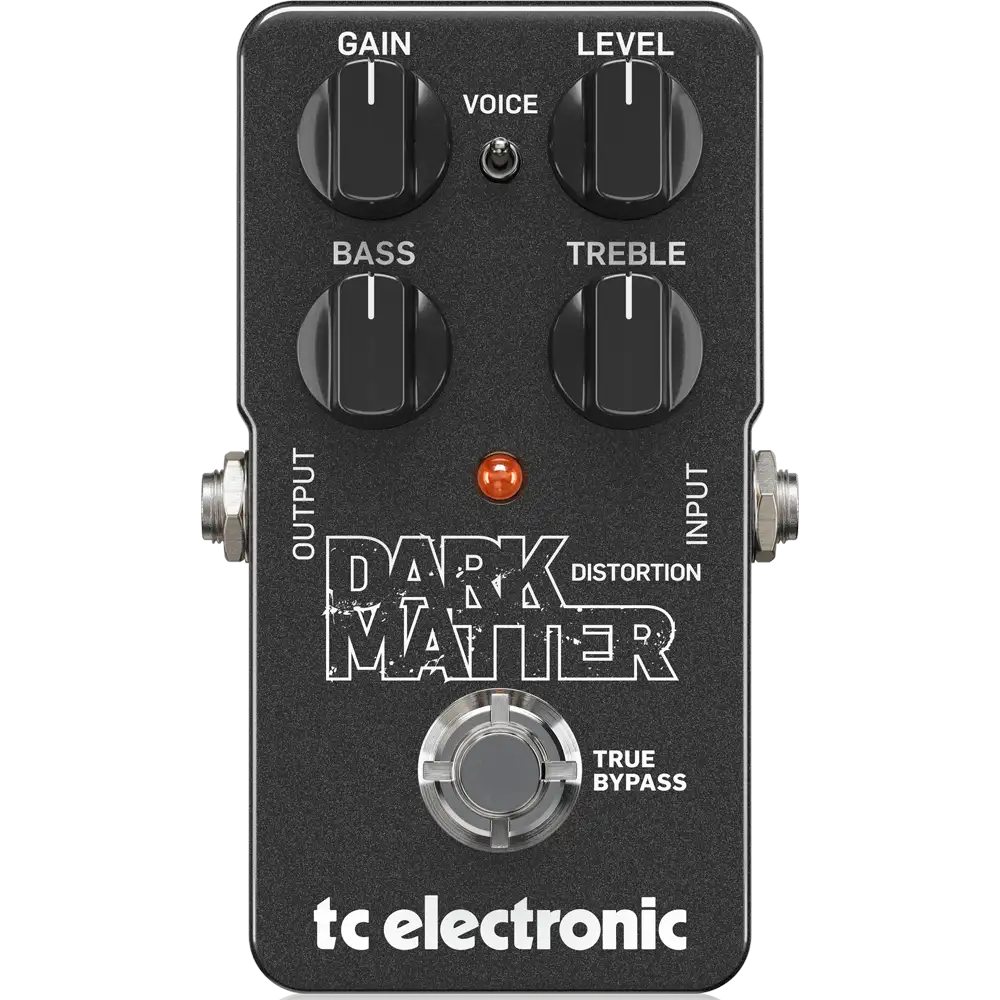
TC Electronic Dark Matter
Guitarsite Expert Opinion
This pedal packs a punch with its range of tones, from bluesy crunch to high-gain plexi-style saturation. It has a unique gain knob behavior and switchable vintage/modern voice, making it a hidden gem for players seeking an affordable all-around distortion pedal.
We’re reader-supported. When you click product links on our site, we may earn an affiliate commission at no extra cost to you.
The TC Electronic Dark Matter is a highly versatile distortion pedal that can be used across various genres and styles, from blues to metal. It has a straightforward design that consists of four knobs: Gain, Level, Bass, and Treble. The Gain knob not only controls the amount of distortion but also alters the sound’s character, ranging from smooth overdrive to aggressive fuzz. The Level knob regulates the output volume, while the Bass and Treble knobs shape the tone. The pedal also comes with a Voice switch that allows you to choose between a vintage or a modern sound.
One of the Dark Matter’s most significant features is that it delivers a natural and dynamic distortion that responds to your guitar playing. The pedal can emulate classic tones or create new ones, depending on how you set it up. It’s compatible with various amps and pedals, and its robust and durable construction ensures it can withstand frequent use. Prominent musicians such as Paul Gilbert, Devin Townsend, and Pete Thorn have used the Dark Matter.
The Dark Matter is an excellent distortion pedal with great versatility and power. Its flexibility makes it ideal for guitarists looking for a pedal to handle any musical situation.
Pros:
- Bass and Treble eq have a good sweep
- Decent gain range
Cons:
- No midrange control
Specifications: | |
|---|---|
Pedal Type: Distortion
| Analog/Digital: Analog
|
Inputs: 1 x 1/4″
| Outputs: 1 x 1/4″
|
Bypass Switching: True Bypass
| Controls: Gain, Level, Bass, Treble, Voice switch
|
Power Source: 9 V DC power supply (sold separately)
| Batteries: 1 x 9V |
Most Versatile
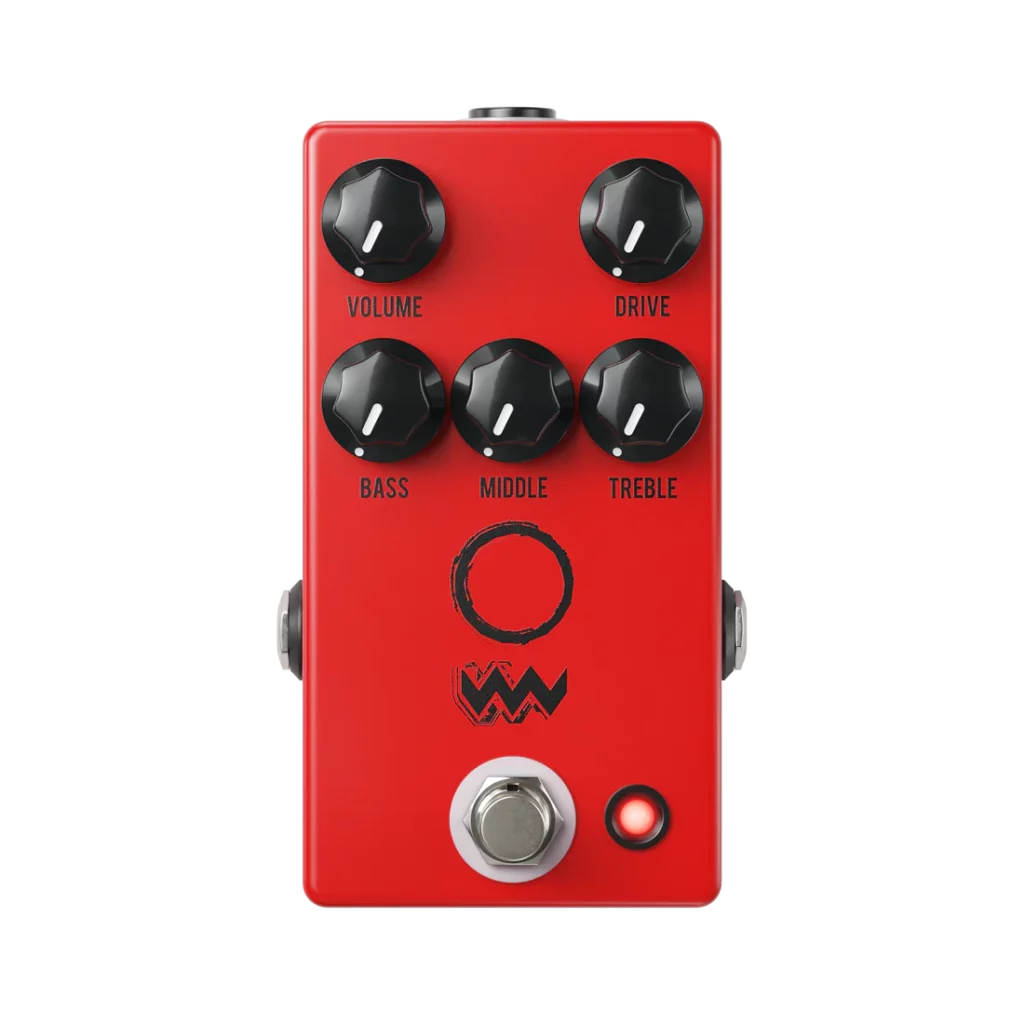
JHS Angry Charlie
Guitarsite Expert Opinion
This high-gain distortion stompbox is inspired by the iconic Marshall JCM800 amplifier, delivering aggressive tones that will ignite your sound.
We’re reader-supported. When you click product links on our site, we may earn an affiliate commission at no extra cost to you.
The JHS Angry Charlie distortion pedal is designed to replicate the classic British amp tones of the Marshall JCM800. It delivers a rich and harmonically saturated distortion ranging from crunch to high gain. It is perfect for guitarists who prefer a cranked Marshall sound but demand more flexibility and control.
The Angry Charlie features Volume, Drive, Bass, Mids, and Treble knobs, along with a switch for Advanced Gain Structure that allows for three different levels of gain and compression. This enables precise sound shaping and customization, essential for guitarists who want to achieve their desired tonal characteristics.
Not only is the Angry Charlie versatile and adaptable to different guitars and amps, but it also caters to various genres, such as rock, metal, blues, and punk. While other distortion pedals need a tube amp to sound good, the angry charlie sounds great with solid state amps as well. The pedal has been used by prominent artists like John Mayer, Gary Clark Jr., and Andy Timmons, a testament to its exceptional quality and reliability.
The JHS Angry Charlie is an exceptional distortion pedal that can turn any amp into a sonic flamethrower. It is an excellent choice for guitarists who desire a powerful and expressive distortion pedal to handle any musical situation.
Pros:
- Marshall JCM800 in a box
- Subtle crunch to searing distortion
- Versatile 3 band eq
Cons:
- Expensive
Specifications: | |
|---|---|
Pedal Type: Distortion
| Analog/Digital: Analog
|
Inputs: 1 x 1/4″
| Outputs: 1 x 1/4″
|
Bypass Switching: True Bypass
| Controls: Volume, Drive, Bass, Middle, Treble
|
Power Source: 9 V DC power supply (sold separately)
| Batteries: 1 x 9V |
Best Overdrive/Distortion
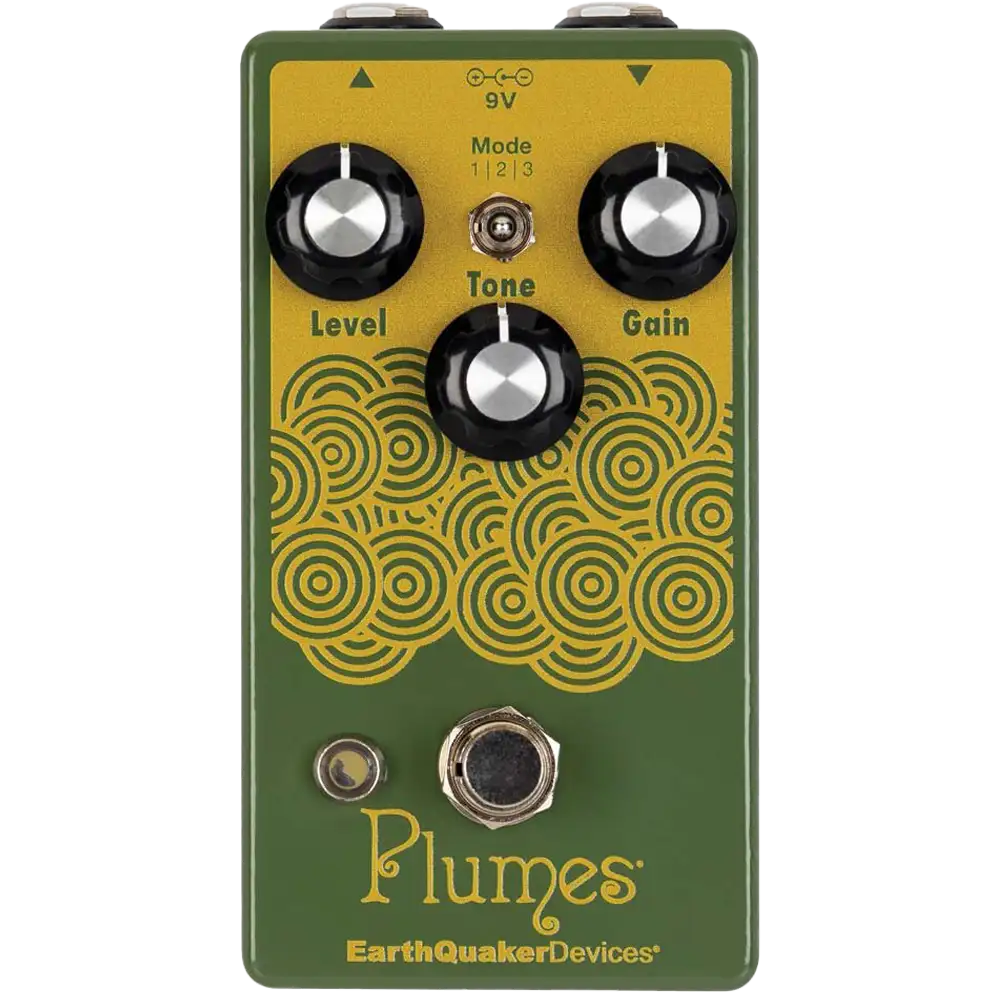
EarthQuaker Devices Plumes
Guitarsite Expert Opinion
The Plumes offers three distinct clipping modes that allow you to craft your perfect sound. With its symmetrical LED clipping, no-diode OpAmp clipping, and TS-style asymmetrical silicone diode drive, this pedal gives you a wide range of tones to play with.
We’re reader-supported. When you click product links on our site, we may earn an affiliate commission at no extra cost to you.
The EarthQuaker Devices Plumes is a versatile and affordable distortion/overdrive pedal. It offers three different clipping modes to suit various playing styles and preferences, including a transparent boost, a classic TS-style drive, and a crunchy distortion.
Even with its versatility, it’s actually one of the most responsive transparent gain pedals around,
The pedal delivers these modes with clarity and headroom, making it a great choice for anyone looking for a low—to medium-gain overdrive that can enhance their tone without masking it.
The Plumes also features a responsive tone control that allows you to shape your sound from warm and smooth to bright and cutting. Additionally, it is built with quality components and incorporates a Flexi-Switch footswitch that enables both latching and momentary switching.
Unlike other distortions, having the gain knob set lower, it can function as a volume boost for your amp or other pedals.
Overall, the Plumes is an overdrive/distortion that can significantly impact your sound thanks to its high-quality construction and versatile features. If you’re looking for the best distortion pedal for any genre, this is it.
Pros:
- Fantastic Tubescreamer variation
- Unique clipping modes bring it to distortion territory
- Wider gain range than original Tubescreamer
Cons:
- Drastic level changes between clipping modes
Specifications: | |
|---|---|
Pedal Type: Distortion
| Analog/Digital: Analog
|
Inputs: 1 x 1/4″
| Outputs: 1 x 1/4″
|
Bypass Switching: True Bypass
| Controls: Level, Tone, Gain, Mode
|
Power Source: 9 V DC power supply (sold separately)
| Batteries: 1 x 9V |
Budget-Friendly Options: Bang for Your Buck
Best Classic Budget
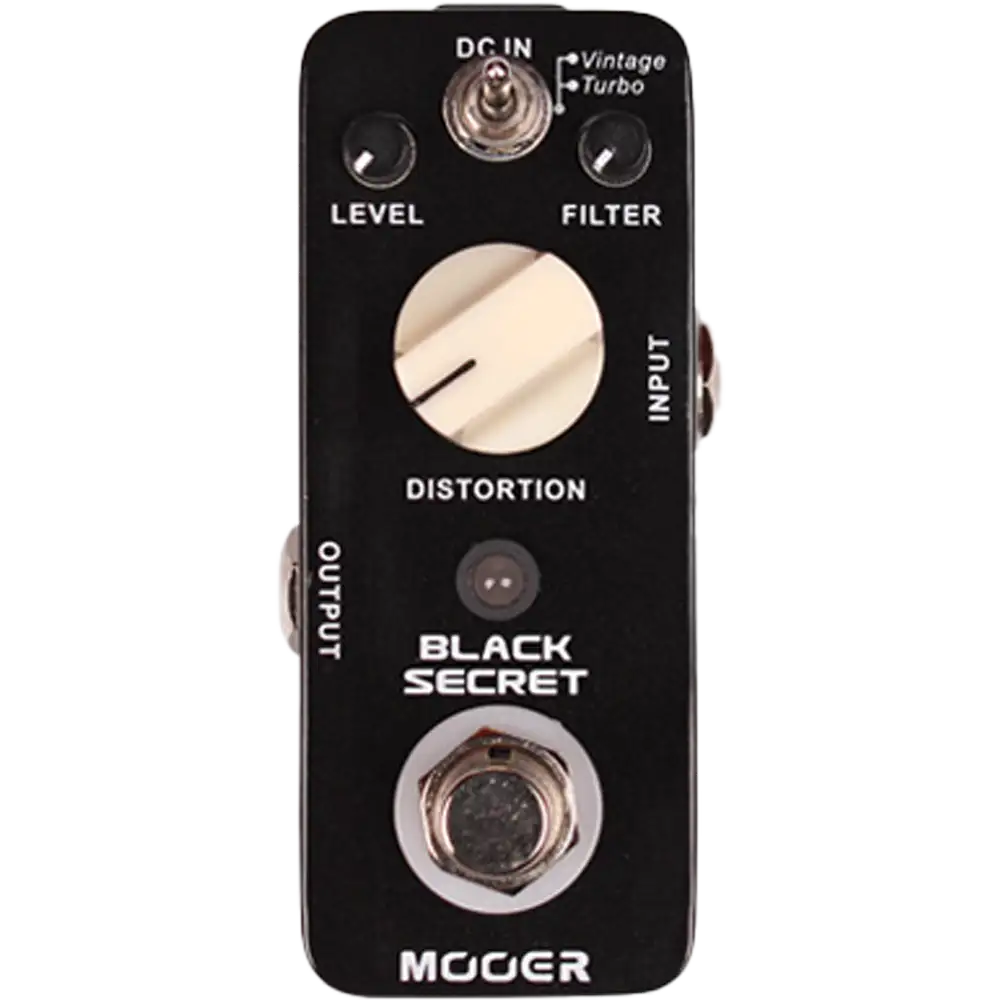
Mooer Black Secret
Guitarsite Expert Opinion
The Mooer Black Secret pays homage to another legendary distortion pedal that needs no introduction. If you’re a true distortion connoisseur, you know exactly what rodent we’re talking about.
We’re reader-supported. When you click product links on our site, we may earn an affiliate commission at no extra cost to you.
The Mooer Black Secret is a mini-sized distortion pedal based on the well-known ProCo RAT circuit. This pedal comes with two modes: vintage and turbo, each offering different levels of gain and compression. The vintage mode presents a warmer and smoother sound, while the turbo mode offers more power and aggression.
This pedal has three knobs: distortion, filter, and volume. The distortion knob controls the amount of saturation, while the filter knob acts as a reverse tone control, cutting treble as you turn it clockwise. The volume knob adjusts the output level.
The Mooer Black Secret produces a gritty, harmonically rich distortion that can cut through the mix. It works well with various guitars and amps and is suitable for different genres, such as rock, metal, blues, and punk. Numerous famous musicians, including Kurt Cobain, Jeff Beck, and David Gilmour, have used the RAT.
Overall, the Mooer Black Secret is a good distortion pedal that offers a powerful and compact solution for guitarists. It is perfect for anyone looking for a versatile pedal to handle any musical situation.
Pros:
- Affordable RAT clone
- Switchable modes
- Compact size
Cons:
- Small knobs
- Volume discrepancy between modes
Specifications: | |
|---|---|
Pedal Type: Distortion
| Analog/Digital: Analog
|
Inputs: 1 x 1/4″
| Outputs: 1 x 1/4″
|
Bypass Switching: True Bypass
| Controls: Level, Filter, Distortion, Mode
|
Power Source: 9 V DC power supply (sold separately)
| Batteries: none |
Best Budget Overall
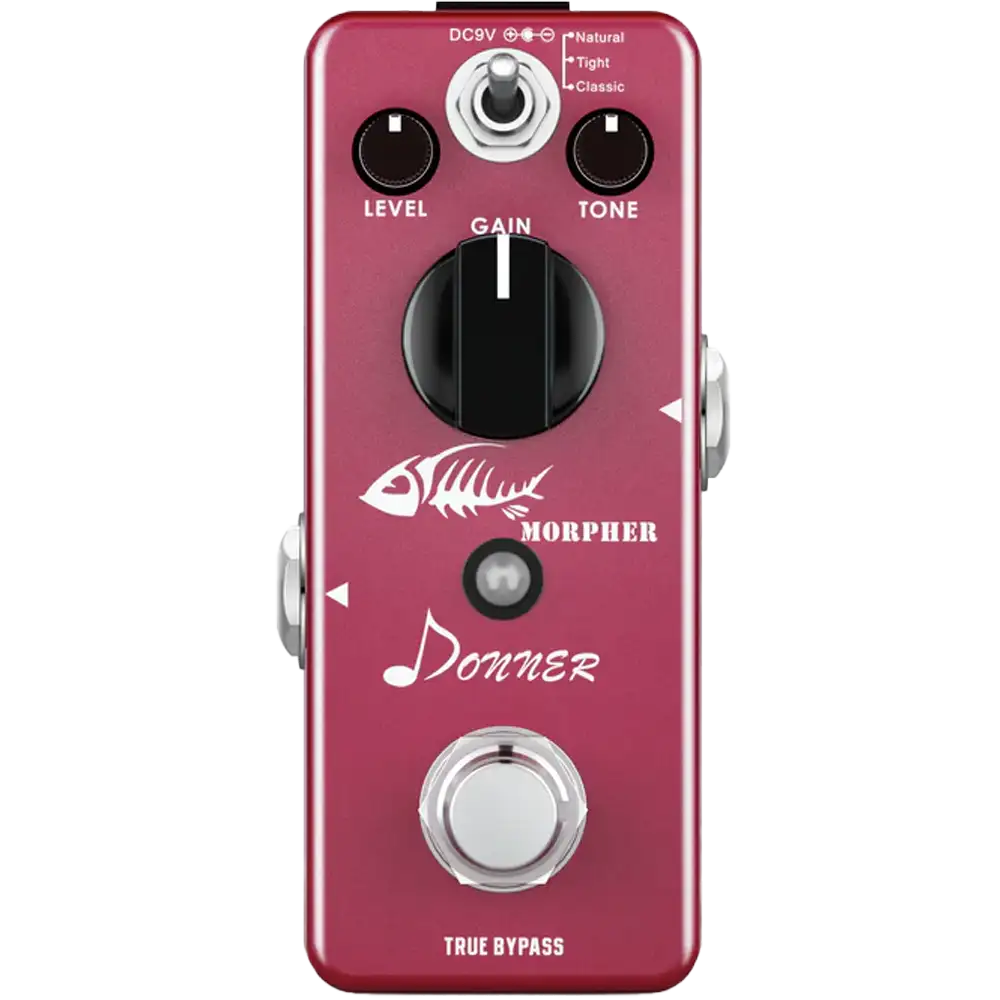
Donner Morpher
Guitarsite Expert Opinion
The Donner Morpher Distortion Pedal is inspired by the Suhr Riot and delivers a powerful, high-gain distortion that will get you shredding in no time.
We’re reader-supported. When you click product links on our site, we may earn an affiliate commission at no extra cost to you.
The Donner Morpher is a high-gain distortion pedal with three modes: natural, tight, and classic crunch. It also has level, gain, and tone controls and a true bypass switch. Its goal is to replicate the sound of the Suhr Riot, a well-known boutique distortion pedal.
The Donner Morpher can produce rich and harmonically saturated distortion ranging from bluesy breakup to full-on metal. It works seamlessly with various guitars and amps and can cover a wide range of genres, including rock, metal, blues, and punk. The pedal’s affordability, sturdy build, and compact size are some of its standout features.
It’s an excellent choice for guitarists who need a versatile and powerful distortion pedal without breaking their budgets.
Pros:
- Excellent for 80's distortion sounds
- Great value
- Compact size
Cons:
- No battery power
Specifications: | |
|---|---|
Pedal Type: Distortion
| Analog/Digital: Analog
|
Inputs: 1 x 1/4″
| Outputs: 1 x 1/4″
|
Bypass Switching: True Bypass
| Controls: Level, Gain, Tone, Mode
|
Power Source: 9 V DC power supply (sold separately)
| Batteries: none |
Behringer Super Fuzz SF300
Best Budget Fuzz/Distortion
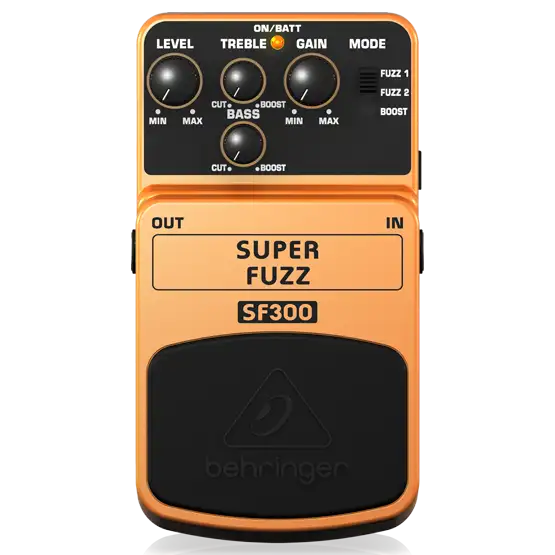
Behringer Super Fuzz SF300
Guitarsite Expert Opinion
Get the Behringer Super Fuzz SF300 if you love classic rock ‘n roll. This pedal’s fuzz tones will transport you back to the ’60s and ’70s.
We’re reader-supported. When you click product links on our site, we may earn an affiliate commission at no extra cost to you.
The Behringer Super Fuzz SF300 is a fuzz pedal based on the Boss FZ-2 Hyper Fuzz, a discontinued pedal popular among fans of doom and stoner metal. The FZ-2 bridged the gap between distortion and fuzz because of its unique circuitry, tone and feel.
The SF300 offers three modes: fuzz 1, fuzz 2, and boost. Fuzz 1 produces a mild fuzz with a vintage feel with a gain range closer to a typical distortion pedal, while fuzz 2 is a more aggressive and modern fuzz with high gain. Boost is a clean boost that can add volume and sparkle to your tone. The pedal also has level, gain, treble, and bass controls to shape your sound.
The SF300 is a loud and intense pedal, especially in fuzz 2 mode, which can create massive and crushing tones. However, it can also be noisy and harsh, making it unsuitable for specific genres and playing styles. The pedal is made of plastic, which may not provide the durability and reliability that some players expect. The battery life is also limited, and a power supply is recommended.
Overall, the SF300 is a great pedal for beginners who want to experiment with fuzz or for experienced players who want to achieve the sound of bands like Electric Wizard, Sleep, or Kyuss. While not very versatile or refined, the SF300 is a fun and affordable option for those seeking a bridge between distortion and fuzz.
Pros:
- Two modes range from classic distortion to modern fuzz
- 2 band eq great for tone shaping
Cons:
- Plastic enclosure
Specifications: | |
|---|---|
Pedal Type: Distortion/Fuzz
| Analog/Digital: Analog
|
Inputs: 1 x 1/4″
| Outputs: 1 x 1/4″
|
Bypass Switching: Buffered Bypass
| Controls: Level, Gain, Treble, Bass, Mode
|
Power Source: 9 V DC power supply (sold separately)
| Batteries: 1 x 9V |
Navigating the Tone Jungle: Buying Advice
Consider Your Desired Sound
Think about the type of distortion you want. Are you after a smooth overdrive, a gritty crunch, or a full-on metal roar? Different distortion / gain pedals offer varying tonal characteristics. There are distortion pedals for metal that have amazing high gain sounds. On the other end of the spectrum, classic distortion pedals like the RAT have a loose but thick sound.
Listen and Research
Check out demos online or better yet, try pedals in person.
Pay attention to how they respond to your playing style and instrument; especially your guitar’s volume knob.
Also take note of whether you have a solid state amp or a tube amp. Some distortion pedals are essentially an amp in a box design so they are made to work well with solid state amps.
Other pedals like the Boss DS1 were designed during a time when tube amps were prominent, so they sound best when paired with them.
If budget is limited, wait for discounted distortion pedal deals.
Match It to Your Playing Style
A moderate gain pedal might be ideal if you play blues or classic rock. For heavier genres, look for pedals with higher gain capabilities. If you prefer lower gain sounds, look into Overdrive Pedals instead as they are often better to use on an already overdriven amp. For fun, you can stack a distortion pedal with an overdrive pedal like an Ibanez tube screamer as guitar players like Steve Vai have done.
Versatility
Some pedals have adjustable gain stages, allowing you to go from mild breakup to extreme distortion. Versatile pedals can adapt to different musical contexts. Some distortion pedals only offer a tone or treble control while others have more comprehensive eq controls like a three band eq or parametric eq.
Sturdy Pedals Withstand Gigging
When selecting a guitar pedal, consider a few key factors. Durability is essential if you plan to use the pedal for live performances. You’ll want a pedal that can withstand the rigors of gigging without breaking down. To achieve this, look for sturdily constructed pedals with reliable switches and reinforced jacks. Such pedals are less likely to malfunction when repeatedly stepped on or subjected to various environmental factors.
Pedalboard Space
Consider the pedal’s size. Will it fit comfortably on your pedalboard alongside other effects? Mini-sized pedals are great for saving space. Some pedals with additional features like an onboard noise gate or three band eq may be larger than usual.
Find the Sweet Spot Between Cost and Quality
When looking for a distortion pedal, finding the right balance between cost and quality is important. With so many options available on the market today, choosing the perfect one that meets both your sonic needs and budget can be overwhelming. That’s why setting a budget and exploring options within that range is essential to ensure you spend your money wisely.
Affordable Gems
However, it’s worth noting that just because a pedal is budget-friendly doesn’t necessarily mean it lacks quality. Some of the most affordable pedals can surprise you with their excellent sound quality. So, don’t underestimate them and give them a try.
Distortion pedals are essential for shaping guitar tones, as they can add character, dynamics, and expression to the sound. Many options are available for guitarists, including classic pedals like the ProCo RAT, the Boss DS-1, and the Electro-Harmonix Big Muff, as well as modern high-gain stompboxes like the Fender Pugilist and the MXR Super Badass. Each pedal has its own unique features and sound, making it suitable for different genres and preferences.
Remember, these guitar pedals are like colors on a palette—each one adds a unique hue to your musical canvas. Now, here’s the exciting part: experimentation! Plug in, twist knobs, and discover your signature sound. Let your creativity flow, whether you’re chasing vintage vibes, modern aggression, or something entirely new.
Raphael Pulgar
Lead Author
Alexander Briones
Editor
